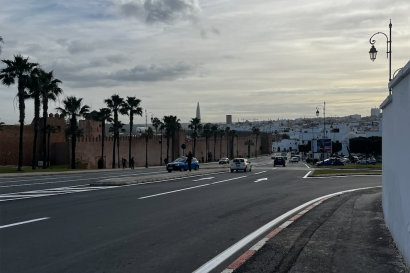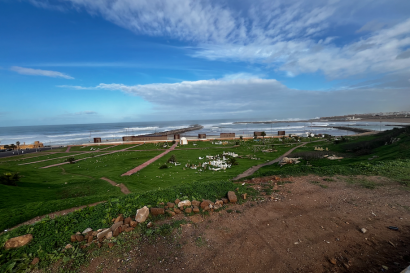Imagine you’re standing at the intersection of a crowded marketplace, the streets sheltered by a combination of wooden roofs, colorful blankets, and repurposed sheets, highlighted by bursts of sunlight peeping through above your head.
Although you're standing still, hundreds of busy students, mothers pushing strollers, cats scrounging for scraps, grandfathers walking hand-in-hand, and the occasional tourist - evident by their water bottles and cross-body bags - flow around you in near-perfect harmony. Vendors call out to you, as many as you can see of every kind: men selling prickly pears, discounted lingerie and pajamas, the fresh fish of the day, cleaned and gutted at your feet, parsley, mint, 100% organic argan oil (really, very natural at good price), and your personal favorite, cow’s head sandwiches.
Evidently, you feel like a bee in a beehive: and there's no better way to describe the "medina" as central to life in main Moroccan cities.
The medina, or the marketplace, is the quintessential hub of life in the Moroccan city as an economic and cultural center. The old medinas are packed with high walls, narrow alleyways, and were historically built with a common bakery, mosque, and hammam (bathhouse) open to the community. They also boast a rich array of goods available for purchase including popcorn kernels, lamps, cleaning supplies, bath products, and hand-dyed textiles.
In a few words, the medina is a microcosm of civilization - a city within a city - that marches to the beat of its own drum. At some point in time, everyone passes through the same medina to purchase baked goods from their favorite vendor. And if, by chance, someone hasn't stopped for a delicious piece of milwi (breakfast bread), they're sure to be seen on Fridays winding through the medina to attend prayer.
My first few experiences in the medina were altogether overwhelming. Personal space was a non-entity, and I felt skittish weaving through the people to reach my destination. Streets and alleyways were rarely marked in the medina, so I often felt lost and out-of-sorts until I learned my way around. In the beginning, clung to my personal belongings and did well to avoid eye contact from the primarily-male vendors, lest I was called into the shop or catcalled as I passed.
When I describe the medina, Iet’s not forget that it's also a residential zone that is home to hundreds of families, one of whom has been incredibly hospitable in hosting me for the semester. Although unassuming from the exterior, most houses in the medina are constructed riad-style and have large interior courtyards that open up to the sky. In my home, beautiful tiles line the periphery of the living room and are broken up by large wooden doors that lead to bedrooms or adjacent furnished rooms. My bedroom is located on the second floor, directly above the kitchen, and I have a nifty balcony from which I can peer into the living room.
I've always been curious as to why most homes in the medina were constructed this way, and in our Islam in Morocco class, I inquired about the historical and religious implications of the structure. Typically, houses have no windows that open to the outdoors and contain curtains that line the doorways because the demarcation of the “private” and “public” spheres is among the most important of beliefs in Islam. We learned that private lives are sacred domains to be shared within the immediate family; thus, the medina and its homes were structured to preserve the private sphere of activity. When I reflected on houses in the United States, I could think of dozens of homes with outward-facing windows to both maximize natural light and support airflow - and I have not encountered any homes like this in the medina.
It's amazing to learn about the origins of certain practices or behaviors and to recognize that Moroccan society - particularly the structure of the medina and its homes - is so deeply rooted in Islam. The closest American comparison I can make of the medina is a permanent farmers’ market in the middle of a high-walled city paved by narrow streets and alleys. Yet this description doesn't do justice to its charisma and energy. The medinas in Rabat, Marrakech, Tangier, Chefchaouen, and Fez each have a remarkable character about them that makes them special and unique.
I no longer feel as overwhelmed by the medina as I did in the beginning - unless I get lost, which merits a small panic and a quick phone call to my roommate. I've really come to enjoy living in the beehive!

Brianna Gist
<p>I am a rising junior studying Linguistics, Government, French, and Spanish at Georgetown University. If all goes right my my life, I would love to devote my career to diplomacy and peace studies or to preserving endangered languages. I am a proud Chicago native and a huge foodie who loves to swim and do bikram yoga. At school, I am a writing consultant specializing in humanities papers, blogs, op-eds, and presentations, and I also sing as a soprano in the Gospel Choir. It is a privilege to be studying abroad in Morocco, and I greatly look forward to my time in Rabat!</p>








